Mar 27 2020
In the last few decades, there has been a considerable increase in crop yields, together with the increasing use of nitrogen fertilizer. Although nitrogen fertilizer is beneficial to crop growth, it has detrimental impacts on the climate and environment, as it needs extremely high energy to produce.

Image Credit: Beverly J. Agtuca, Sylwia A. Stopka, Thalita R. Tuleski, Fernanda P. do Amaral, Sterling Evans, Yang Liu, Dong Xu, Rose Adele Monteiro, David W. Koppenaal, Ljiljana Paša-Tolic, Christopher R. Anderton, Akos Vertes, and Gary Stacey.
Several researchers are finding methods to create more sustainable practices that preserve high crop yields with less inputs.
A more sustainable way to provide nitrogen to crops would be through the use of biological nitrogen fixation, a practice well developed for leguminous crops. A variety of nitrogen fixing bacteria are common in the rhizosphere of most plants. However, such plant growth promoting bacteria (PGPB) have seen only limited use as inoculants in agriculture.
Gary Stacey, Plant Pathologist, University of Missouri
According to Stacey and his collaborator, the restricted use of fertilizers is caused by the common issues related to the use of biologicals for crop production and inconsistent efficacy upon being applied.
The researchers performed a study to gain better insights into the metabolic response of the plant host to bring down the difference observed in the response of crops to PGPB.
One challenge with our research is that, while PGPB can colonize roots to high levels, the sites of colonization can be highly localized. Hence, isolating whole roots results in a considerable dilution of any signal due to the great majority of the root cells not in contact with the bacteria.
Gary Stacey, Plant Pathologist, University of Missouri
Stacey and his team used laser ablation electrospray ionization mass spectrometry (LAESI-MS) to solve this problem. This method enabled them to sample only those sites that are infected by the bacteria, which could be localized through the expression of green fluorescent protein.
The study outcomes demonstrated that bacterial colonization leads to considerable shifts in plant metabolism. A few metabolites were found to be more abundant in inoculated plants, and others (such as metabolites indicative of nitrogen) were decreased in roots inoculated or uninoculated with a bacterial strain not able to fix nitrogen.
Interestingly, compounds, involved in indole-alkaloid biosynthesis were more abundant in the roots colonized by the fix-strain, perhaps reflecting a plant defense response. Ultimately, through such research, we hope to define the molecular mechanisms by which PGPB stimulate plant growth so as to devise effective and consistent inoculation protocols to improve crop performance.
Gary Stacey, Plant Pathologist, University of Missouri
Stacey’s laboratory has generally focused on plant-microbe interactions and biological nitrogen fixation. Since biological nitrogen fixation (BNF) was discovered, the aim of the lab has been to leverage the advantages of BNF for non-leguminous crops like maize. Although PGPB exhibit this capacity by nature, it has not been properly captured for agricultural production.
“We believe that, in contrast to other better studied interactions, such as rhizobium-legume, this is due to a general lack of information about the molecular mechanisms by which PGPB stimulate plant growth. Hence, we have undertaken in our lab projects that seek to provide this information in the belief that such information will increase the efficacy of PGPG inoculants with the net effect to increase their use for crop production,” added Stacey.
Stacey and his group were highly surprised to discover that they were not able to observe a considerable effect on phytohormone production that was in close correlation to the ability of PGPB to improve plant growth.
This indicates that PGPB considerably affects plant metabolism than achieved earlier. This probably points to more intricate explanations of how these bacteria affect plant growth.